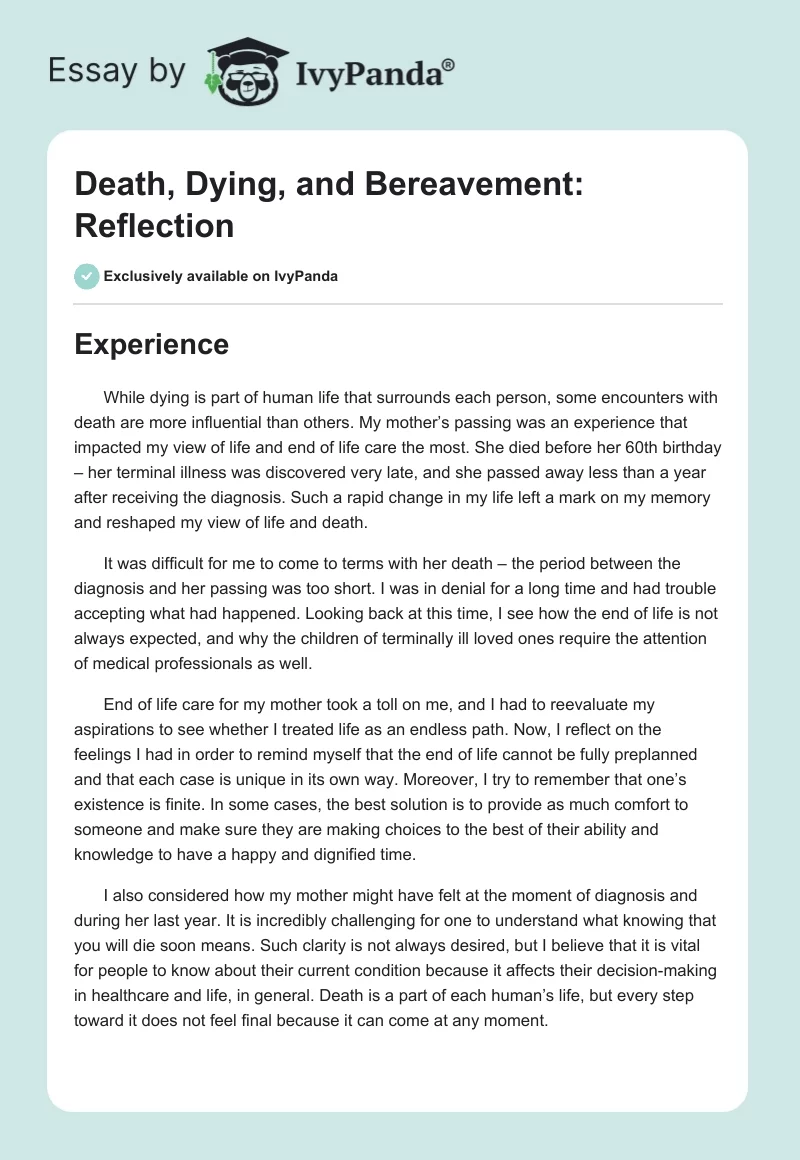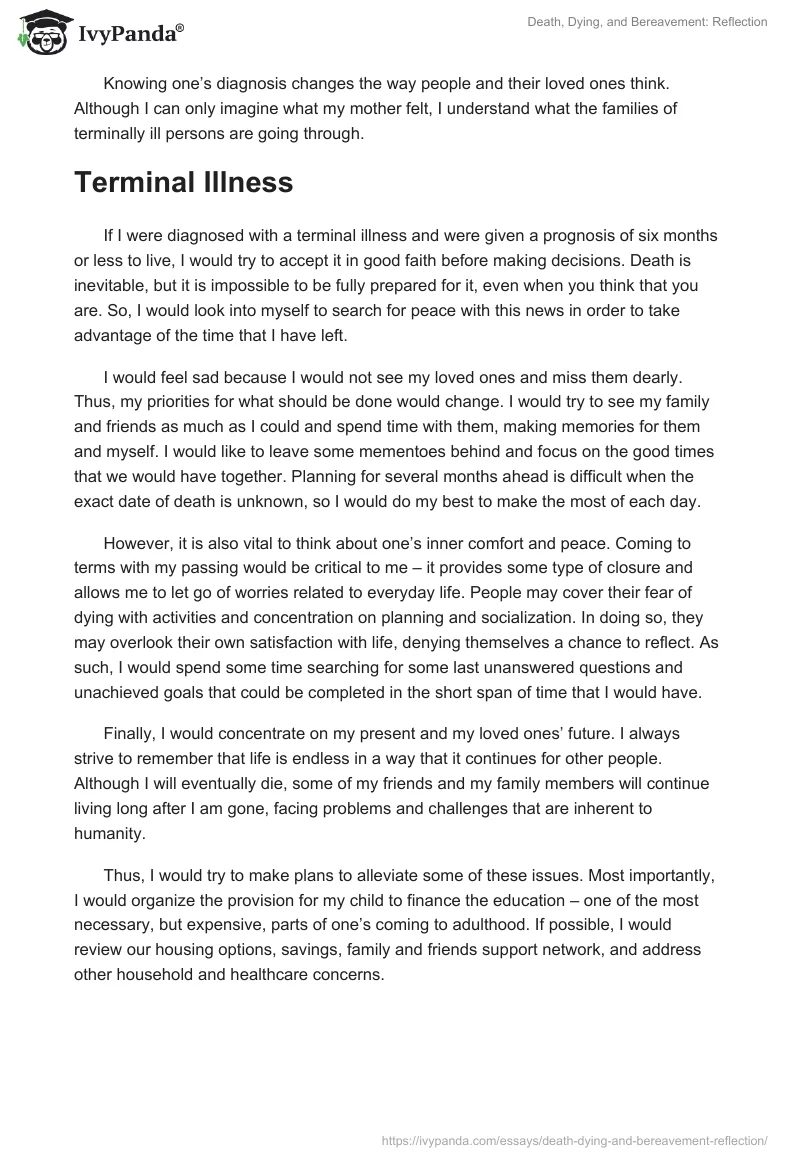Experience
While dying is part of human life that surrounds each person, some encounters with death are more influential than others. My mother’s passing was an experience that impacted my view of life and end of life care the most. She died before her 60th birthday – her terminal illness was discovered very late, and she passed away less than a year after receiving the diagnosis. Such a rapid change in my life left a mark on my memory and reshaped my view of life and death.
It was difficult for me to come to terms with her death – the period between the diagnosis and her passing was too short. I was in denial for a long time and had trouble accepting what had happened. Looking back at this time, I see how the end of life is not always expected, and why the children of terminally ill loved ones require the attention of medical professionals as well.
End of life care for my mother took a toll on me, and I had to reevaluate my aspirations to see whether I treated life as an endless path. Now, I reflect on the feelings I had in order to remind myself that the end of life cannot be fully preplanned and that each case is unique in its own way. Moreover, I try to remember that one’s existence is finite. In some cases, the best solution is to provide as much comfort to someone and make sure they are making choices to the best of their ability and knowledge to have a happy and dignified time.
I also considered how my mother might have felt at the moment of diagnosis and during her last year. It is incredibly challenging for one to understand what knowing that you will die soon means. Such clarity is not always desired, but I believe that it is vital for people to know about their current condition because it affects their decision-making in healthcare and life, in general. Death is a part of each human’s life, but every step toward it does not feel final because it can come at any moment.
Knowing one’s diagnosis changes the way people and their loved ones think. Although I can only imagine what my mother felt, I understand what the families of terminally ill persons are going through.
Terminal Illness
If I were diagnosed with a terminal illness and were given a prognosis of six months or less to live, I would try to accept it in good faith before making decisions. Death is inevitable, but it is impossible to be fully prepared for it, even when you think that you are. So, I would look into myself to search for peace with this news in order to take advantage of the time that I have left.
I would feel sad because I would not see my loved ones and miss them dearly. Thus, my priorities for what should be done would change. I would try to see my family and friends as much as I could and spend time with them, making memories for them and myself. I would like to leave some mementoes behind and focus on the good times that we would have together. Planning for several months ahead is difficult when the exact date of death is unknown, so I would do my best to make the most of each day.
However, it is also vital to think about one’s inner comfort and peace. Coming to terms with my passing would be critical to me – it provides some type of closure and allows me to let go of worries related to everyday life. People may cover their fear of dying with activities and concentration on planning and socialization. In doing so, they may overlook their own satisfaction with life, denying themselves a chance to reflect. As such, I would spend some time searching for some last unanswered questions and unachieved goals that could be completed in the short span of time that I would have.
Finally, I would concentrate on my present and my loved ones’ future. I always strive to remember that life is endless in a way that it continues for other people. Although I will eventually die, some of my friends and my family members will continue living long after I am gone, facing problems and challenges that are inherent to humanity.
Thus, I would try to make plans to alleviate some of these issues. Most importantly, I would organize the provision for my child to finance the education – one of the most necessary, but expensive, parts of one’s coming to adulthood. If possible, I would review our housing options, savings, family and friends support network, and address other household and healthcare concerns.
End of Life Issue
Doctors and nurses in end-of-life care carry a significant burden in working with patients and families dealing with ethical and moral dilemmas. Some of these issues are also regulated legally, although the lines of what is legal or not are much less clear than in other cases. For me, one of the moral dilemmas that I had struggled with was the patients’ and relatives’ differing views on treatment planning. In some situations, the client’s family members may not pursue the same goals as the person under care. These aims can be guided by religious or personal views on health and death. Others can be motivated by financial problems, strained relationships, emotional health, and a multitude of other reasons.
For example, in a hospital, a family may not want the patient to know the diagnosis as it could scare or sadden them. In this scenario, I turn to the some of the medical principles as the basis for my value system. I would highlight the importance of fidelity – people have the right to known about their prognosis and diagnosis (Karnik & Kanekar, 2016). I think that truthfulness is a necessary part of end-of-life care and support, even though telling someone their diagnosis is difficult.
In some situations, children want to keep their parent alive as long as possible and request all possible procedures, while the client denies care and seeks comfort to spend the last days with dignity. Here, the principle of autonomy would guide my practice – people reserve the right to make decisions to the extent of their capacity (De Panfilis et al., 2019).
Moreover, it is vital to remember that rigorous treatment does not equal beneficence in all scenarios. I try to approach each case individually and acknowledge that every person has the right to control a part of their destiny through healthcare or outreach for support, and the duty of caring professionals is to inform our clients of all the choices they can make and what outcomes they can expect. In the end, medical science advances continuously, but death remains an unchanging aspect that requires person-centered thinking.
References
De Panfilis, L., Di Leo, S., Peruselli, C., Ghirotto, L., & Tanzi, S. (2019). “I go into crisis when…”: Ethics of care and moral dilemmas in palliative care. BMC Palliative Care, 18(70), 1-8. Web.
Karnik, S., & Kanekar, A. (2016). Ethical issues surrounding end-of-life care: A narrative review. Healthcare, 4(24), 1-6. Web.


